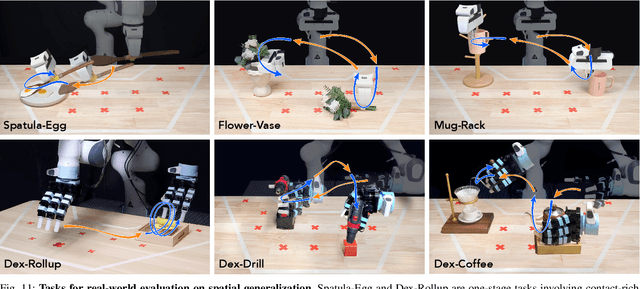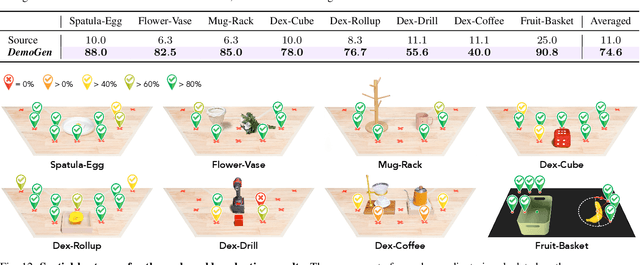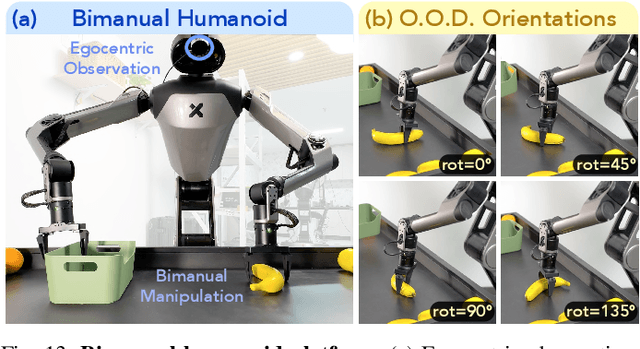Yixuan Wang
Initialization Schemes for Kolmogorov-Arnold Networks: An Empirical Study
Sep 03, 2025Abstract:Kolmogorov-Arnold Networks (KANs) are a recently introduced neural architecture that replace fixed nonlinearities with trainable activation functions, offering enhanced flexibility and interpretability. While KANs have been applied successfully across scientific and machine learning tasks, their initialization strategies remain largely unexplored. In this work, we study initialization schemes for spline-based KANs, proposing two theory-driven approaches inspired by LeCun and Glorot, as well as an empirical power-law family with tunable exponents. Our evaluation combines large-scale grid searches on function fitting and forward PDE benchmarks, an analysis of training dynamics through the lens of the Neural Tangent Kernel, and evaluations on a subset of the Feynman dataset. Our findings indicate that the Glorot-inspired initialization significantly outperforms the baseline in parameter-rich models, while power-law initialization achieves the strongest performance overall, both across tasks and for architectures of varying size. All code and data accompanying this manuscript are publicly available at https://github.com/srigas/KAN_Initialization_Schemes.
High precision PINNs in unbounded domains: application to singularity formulation in PDEs
Jun 24, 2025Abstract:We investigate the high-precision training of Physics-Informed Neural Networks (PINNs) in unbounded domains, with a special focus on applications to singularity formulation in PDEs. We propose a modularized approach and study the choices of neural network ansatz, sampling strategy, and optimization algorithm. When combined with rigorous computer-assisted proofs and PDE analysis, the numerical solutions identified by PINNs, provided they are of high precision, can serve as a powerful tool for studying singularities in PDEs. For 1D Burgers equation, our framework can lead to a solution with very high precision, and for the 2D Boussinesq equation, which is directly related to the singularity formulation in 3D Euler and Navier-Stokes equations, we obtain a solution whose loss is $4$ digits smaller than that obtained in \cite{wang2023asymptotic} with fewer training steps. We also discuss potential directions for pushing towards machine precision for higher-dimensional problems.
Tag-Evol: Achieving Efficient Instruction Evolving via Tag Injection
May 30, 2025Abstract:Evol-Instruct has made significant improvements as a data synthesis method in several areas. Existing methods typically rely on a fixed set of strategies to evolve, which require manual design and are monolithic in form. In addition, iterative evolution also makes the acquisition of hard samples expensive. In view of this, we propose the Tag-Evol framework, a more diverse and efficient instruction evolving method. Specifically, Tag-Evol uses diverse and specific knowledge tags as strategies to achieve controlled evolution by injecting different combinations of tags into the original instructions. Experiments with multiple backbones in diverse domain benchmarks show that the proposed method generates significantly better evolved data than other methods. Furthermore, we conduct a thorough analysis of the evolved data, demonstrating that Tag-Evol is not only efficient but also generates more diverse and challenging data.
Pretraining Language Models to Ponder in Continuous Space
May 27, 2025Abstract:Humans ponder before articulating complex sentence elements, enabling deeper cognitive processing through focused effort. In this work, we introduce this pondering process into language models by repeatedly invoking the forward process within a single token generation step. During pondering, instead of generating an actual token sampled from the prediction distribution, the model ponders by yielding a weighted sum of all token embeddings according to the predicted token distribution. The generated embedding is then fed back as input for another forward pass. We show that the model can learn to ponder in this way through self-supervised learning, without any human annotations. Our method is straightforward and can be seamlessly integrated with various existing language models. Experiments across three widely used open-source architectures-GPT-2, Pythia, and LLaMA-and extensive downstream task evaluations demonstrate the effectiveness and generality of our method. For language modeling tasks, pondering language models achieve performance comparable to vanilla models with twice the number of parameters. On 9 downstream benchmarks, our pondering-enhanced Pythia models significantly outperform the official Pythia models. Notably, pondering-enhanced Pythia-1B is comparable to TinyLlama-1.1B, which is trained on 10 times more data. The code is available at https://github.com/LUMIA-Group/PonderingLM.
Lookahead Q-Cache: Achieving More Consistent KV Cache Eviction via Pseudo Query
May 24, 2025Abstract:Large language models (LLMs) rely on key-value cache (KV cache) to accelerate decoding by reducing redundant computations. However, the KV cache memory usage grows substantially with longer text sequences, posing challenges for efficient deployment. Existing KV cache eviction methods prune tokens using prefilling-stage attention scores, causing inconsistency with actual inference queries, especially under tight memory budgets. In this paper, we propose Lookahead Q-Cache (LAQ), a novel eviction framework that generates low-cost pseudo lookahead queries to better approximate the true decoding-stage queries. By using these lookahead queries as the observation window for importance estimation, LAQ achieves more consistent and accurate KV cache eviction aligned with real inference scenarios. Experimental results on LongBench and Needle-in-a-Haystack benchmarks show that LAQ outperforms existing methods across various budget levels, achieving a 1 $\sim$ 4 point improvement on LongBench under limited cache budget. Moreover, LAQ is complementary to existing approaches and can be flexibly combined to yield further improvements.
Think Before You Accept: Semantic Reflective Verification for Faster Speculative Decoding
May 24, 2025Abstract:Large language models (LLMs) suffer from high inference latency due to the auto-regressive decoding process. Speculative decoding accelerates inference by generating multiple draft tokens using a lightweight model and verifying them in parallel. However, existing verification methods rely heavily on distributional consistency while overlooking semantic correctness, thereby limiting the potential speedup of speculative decoding. While some methods employ additional models for relaxed verification of draft tokens, they often fail to generalize effectively to more diverse or open-domain settings. In this work, we propose Reflective Verification, a training-free and semantics-aware approach that achieves a better trade-off between correctness and efficiency. Specifically, we leverage the inherent reflective capacity of LLMs to semantically assess the correctness of draft tokens in parallel during verification. Using prompt-based probing, we obtain both the original and reflective distributions of draft tokens in a single forward pass. The fusion of these distributions enables semantic-level verification of draft tokens that incorporates both consistency and correctness. Experiments across multiple domain benchmarks and model scales demonstrate that our method significantly increases the acceptance length of draft tokens without compromising model performance. Furthermore, we find that the proposed Reflective Verification is orthogonal to existing statistical verification methods, and their combination yields additional 5$\sim$15\% improvements in decoding speed.
Success is in the Details: Evaluate and Enhance Details Sensitivity of Code LLMs through Counterfactuals
May 20, 2025Abstract:Code Sensitivity refers to the ability of Code LLMs to recognize and respond to details changes in problem descriptions. While current code benchmarks and instruction data focus on difficulty and diversity, sensitivity is overlooked. We first introduce the CTF-Code benchmark, constructed using counterfactual perturbations, minimizing input changes while maximizing output changes. The evaluation shows that many LLMs have a more than 10\% performance drop compared to the original problems. To fully utilize sensitivity, CTF-Instruct, an incremental instruction fine-tuning framework, extends on existing data and uses a selection mechanism to meet the three dimensions of difficulty, diversity, and sensitivity. Experiments show that LLMs fine-tuned with CTF-Instruct data achieve over a 2\% improvement on CTF-Code, and more than a 10\% performance boost on LiveCodeBench, validating the feasibility of enhancing LLMs' sensitivity to improve performance.
FreqKV: Frequency Domain Key-Value Compression for Efficient Context Window Extension
May 01, 2025Abstract:Extending the context window in large language models (LLMs) is essential for applications involving long-form content generation. However, the linear increase in key-value (KV) cache memory requirements and the quadratic complexity of self-attention with respect to sequence length present significant challenges during fine-tuning and inference. Existing methods suffer from performance degradation when extending to longer contexts. In this work, we introduce a novel context extension method that optimizes both fine-tuning and inference efficiency. Our method exploits a key observation: in the frequency domain, the energy distribution of the KV cache is primarily concentrated in low-frequency components. By filtering out the high-frequency components, the KV cache can be effectively compressed with minimal information loss. Building on this insight, we propose an efficient compression technique, FreqKV, that iteratively compresses the increasing KV cache to a fixed size in the frequency domain, applicable to both fine-tuning and inference. FreqKV introduces no additional parameters or architectural modifications. With minimal fine-tuning, LLMs can learn to leverage the limited cache that is compressed in the frequency domain and extend the context window efficiently. Experiments on various long context language modeling and understanding tasks demonstrate the efficiency and efficacy of the proposed method.
Directly Forecasting Belief for Reinforcement Learning with Delays
May 01, 2025Abstract:Reinforcement learning (RL) with delays is challenging as sensory perceptions lag behind the actual events: the RL agent needs to estimate the real state of its environment based on past observations. State-of-the-art (SOTA) methods typically employ recursive, step-by-step forecasting of states. This can cause the accumulation of compounding errors. To tackle this problem, our novel belief estimation method, named Directly Forecasting Belief Transformer (DFBT), directly forecasts states from observations without incrementally estimating intermediate states step-by-step. We theoretically demonstrate that DFBT greatly reduces compounding errors of existing recursively forecasting methods, yielding stronger performance guarantees. In experiments with D4RL offline datasets, DFBT reduces compounding errors with remarkable prediction accuracy. DFBT's capability to forecast state sequences also facilitates multi-step bootstrapping, thus greatly improving learning efficiency. On the MuJoCo benchmark, our DFBT-based method substantially outperforms SOTA baselines.
DemoGen: Synthetic Demonstration Generation for Data-Efficient Visuomotor Policy Learning
Feb 24, 2025



Abstract:Visuomotor policies have shown great promise in robotic manipulation but often require substantial amounts of human-collected data for effective performance. A key reason underlying the data demands is their limited spatial generalization capability, which necessitates extensive data collection across different object configurations. In this work, we present DemoGen, a low-cost, fully synthetic approach for automatic demonstration generation. Using only one human-collected demonstration per task, DemoGen generates spatially augmented demonstrations by adapting the demonstrated action trajectory to novel object configurations. Visual observations are synthesized by leveraging 3D point clouds as the modality and rearranging the subjects in the scene via 3D editing. Empirically, DemoGen significantly enhances policy performance across a diverse range of real-world manipulation tasks, showing its applicability even in challenging scenarios involving deformable objects, dexterous hand end-effectors, and bimanual platforms. Furthermore, DemoGen can be extended to enable additional out-of-distribution capabilities, including disturbance resistance and obstacle avoidance.
 Add to Chrome
Add to Chrome Add to Firefox
Add to Firefox Add to Edge
Add to Edge